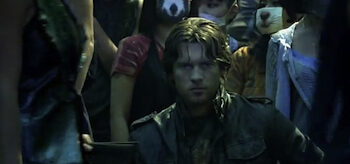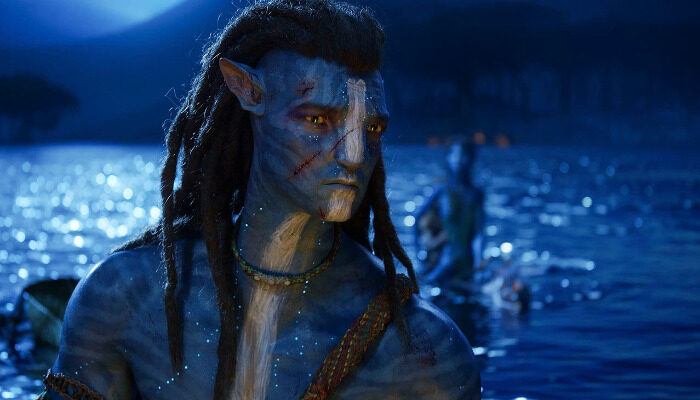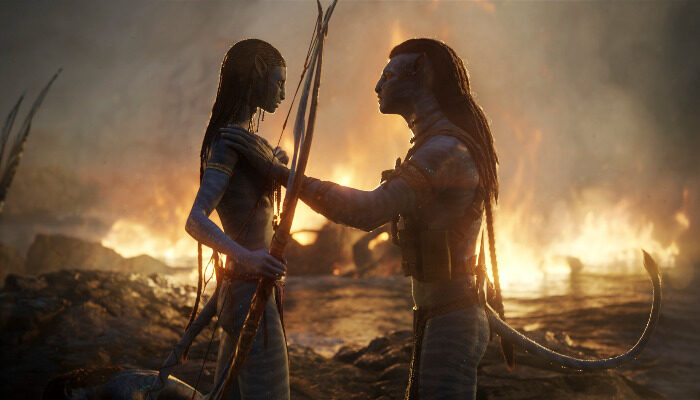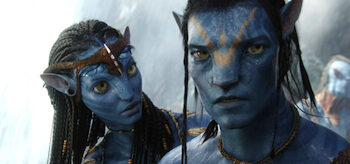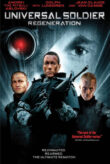Film Review: Avatar (2009)
Avatar is a hybrid sci-fi, hero-going-native film with audacious, blazing, state of the art CGI and 3-D effects. Director James Cameron has created a film with the earmarks of the future all over it. Constantly upping the eye-candy currency, the story, at times, becomes a non-issue. Much like the action movies of decades past, stuff gets blown up and the viewer literally wants to reach out and touch what is going on during certain scenes. After the film’s CGI brilliance becomes a normality and the viewer adjust to it, their attention diverts to the meat of the movie, the story. Unfortunately for Avatar, after gorging themselves on its visuals, the viewer may want a story equally as impressive. They will not find it with Avatar. In Avatar’s defense, there are not many films whose storylines are up to the task of matching Avatar’s visuals. In that respect, Avatar shoots itself in the foot, bearing its own weight and floundering when it comes time for exposition.
Adding to the chorus of semi-harmonious diatribes about how Avatar is Dances with Wolves-lite, the viewer has seen the characters realized in Avatar far better before. The characters in Avatar are generic representations of many of the characters found within the territories of Dances with Wolves’ but without depth. They are as interchangeable as the characters in Event Horizon.
Lieutenant John J. Dunbar in Dances with Wolves is injured at the beginning of the film while Corporal Jake Sully (Sam Worthington) in Avatar comes injured from a previous battle. Lt. Dunbar goes off to the frontier, a land he has heard about. Cpl. Sully does the same. Lt. Dunbar encounters the natives of that area, the Lakota, and begins learning their ways and customs. Cpl. Sully does the same with the Na ‘vi on Pandora. Lt. Dunbar becomes disgruntled with his own kind and chooses to side with and lives with the natives. Cpl. Sully does so as well expect in Dances with Wolves, its far more compelling, sad, and regrettable. The viewer feels sorry for what Lt. Dunbar is put through, for both the unintentional malfeasance and the outright violence bestowed upon him. In Avatar, the viewer is mostly ambivalent to what happens to Cpl. Sully because the violence mostly happens to his avatar, not him. If the viewer had seen Cpl. Sully receive the injury that paralyzed him as they did to Ron Kovic in Born on the Fourth of July, this might not have been the case.
The action and intensity of Avatar is nowhere near as high as in Terminator, Terminator 2: Judgment Day, The Abyss or Aliens. There is that Cameron build up but the pay-off is nowhere near as high as in the aforementioned films. On the surface, the PG-13 rating cultivated by and bestowed upon Avatar could be blamed but that is not the case because The Lord of the Rings: The Return of the King was highly intense and had the same rating (I still don’t know how that finger biting off scene on Mount Doom got by the ratings board). Cameron intentional pulled his punches. Whether this was for economic reasons, there was no reason to “go there” or the story didn’t call for droplets of plasma and bloodshed are questions and quandaries only Cameron can answer. From what I have read, however, it was to maintain the PG-13 rating.
Avatar is sorely missing the grit of Aliens, that film’s multifaceted characters, and its singular depth. Characters change in a hollow, predictable ways in Avatar whereas in Aliens, the characters changed in unpredictable ways, case and point: Ellen Ripley and Private William Hudson.
The “bad guy” in Avatar, Colonel Miles Quaritch (Stephen Lang), is not inherently evil, he is a soldier given a commission and will do what it takes to carry it out. He couldn’t care less about anything outside the realm of that. Like Gunnery Sergeant Asher “Sarge” Mahonin said in Bartkowiak’s Doom when asked about seeing something negative outside the scope of his mission: “I didn’t see shit. I don’t get paid to see shit.” Col. Quaritch has no hidden agenda. He doesn’t even hate the creatures that disfigured the side of his head. It would be a trite Moby Dick cliché if he did but there is also nothing to his character beyond his actions. In this he is saved to a degree because he always acts, he never asks someone else to do something when he is capable of doing it himself. At one point he goes outside in the lethal environment, holds his breathe, and uses his machine gun then his handgun on escaping traitors. This kind of single-minded, army-of-one mentality was great to see but it was never built upon personality-wise. It was like watching a slightly better written and “AMP”ed up version of Nero from Abram’s Star Trek all over again. Col. Quaritch is a means to an end, a story element but one with a pulse, a could-have-been.
Battle for Terra, involving situational similarities to Avatar, possesses the original storyline this CGI spectacle deserved to and should have had. In almost every way Avatar is hackneyed, Battle for Terra is not. Where humans come to Pandora for greed, humans come to Planet Terra for the survival of the species. Because of this, the dynamics and imperatives in Battle for Terra are escalated, the stakes are higher. When amoral decisions are made by the humans, they are made by trapped, 7th Generation submariners that have only known a decaying metallic ship all their lives, one that is rapidly losing the ability to sustain human life. It’s Terra or death. On Pandora, it is we get paid or we go home empty handed for all of our deforestation efforts.
James Cameron’s Avatar is a ballistic, 3-D eye candy extravaganza whose story quality could not possibly match its visuals. It starts and ends with Corporal Jake Sully. Cameron was in too big of a hurry to get him to Pandora and didn’t spend enough time on him like he did with Ripley before taking her back to LV-426, Queen Bitch of the Galaxy before she dove down to “her” rig or Rose before that boat, what’s-its-name, sank. Avatar is a film that, if stripped of its visuals, would be like Robocop stripped of its metal: chunks of common, base organic elements with no backbone. This reality is present because of Avatar’s inherent premise: the strong taking from the weak, an ancient story, so ancient in fact that we have seen it innumerable times before.
Rating: 8/10
Related Articles
FilmBook's Newsletter
Subscribe to FilmBook’s Daily Newsletter for the latest news!







